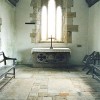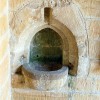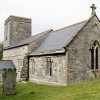One miserable morning nine centuries ago a group of despondent monks were trudging forlornly through the village of Thorncombe on their way home to Waverley Abbey in Surrey, a place they had left almost a decade earlier. They had spent the intervening years at Brightley in Devon where in 1136 they established a Cistercian Monastery.
Following the death of their patron Richard de Brioniis and finding the land at Brightley was too barren, the monks abandoned the project and decided to return to their home Abbey. As they passed through Thorncombe they met Adelicia de Brioniis who listened to their tale of woe and told them she was the sister of their patron. Adelicia honoured the wish of her late brother and offered the monks the use of the Manor of Thorncombe and a site by the River Axe at Harescath (Cleveland says: Heresbath), later known as Forde. In that same year the Abbey was re-founded and within seven years the Monastery of Forde Abbey was built. Boswell says: “it is generally understood that a part of her design was, to make it a place of refuge for those whom the war between the Empress Matilda and King Stephen might have ruined.” The monastery flourished and for four centuries it was well known as a seat of learning.
Abbot Baldwin, the third abbot, had been Bishop of Worcester and from 1184 until his death on the 19th of November 1190 he was Archbishop of Canterbury; he had only been in his role as Abbot of Forde Abbey for a year before his death. King Richard the Lionheart sent Baldwin ahead to the Holy Land; he was present at the fighting with Saladin at Acre, where he fell victim to pestilence and died.
John Devonius was the fourth abbot from 1191 to 1214. He was said to be one of the most learned men of his day and he was confessor to King John. He wrote Sermons on the Final Verses of the Song of Songs a work that has been passed down through the centuries and is still in print today – even being available from Amazon! Abbot John had previously been Prior at Forde before going to Bindon Abbey at Wool. He died on the 21st of April 1214. Forde Abbey became a wealthy foundation and by the 14th century owned some 30,000 acres of land.
The last abbot, Abbot Chard, was appointed in 1521. He set about restructuring the fabric of the building and spent all the available monastic money repairing and restoring the existing Cistercian building and completing some extensions. The dissolution of the larger monasteries came in 1539, Abbot Chard, after delaying the surrender of the monastery at the end, opted to quietly hand Forde Abbey to Henry Vlll. Chard then became vicar of Thorncombe, a position he held until his death in 1543.
The Abbey and its lands were leased by the Crown to Richard Pollard. During the next century there followed a succession of distant landlords. It was in this period that the Abbey Church, all 190 feet of it, was lost; stone was stolen and the abbey vandalised.
Then, in 1649 salvation for Forde Abbey came when it was purchased by Edmund Prideaux, who transformed the building into a private home. Prideaux was Member of Parliament for Lyme Regis and a supporter of the parliamentary cause; he became Oliver Cromwell’s Attorney General.
In 1659 Edmund Prideaux died and was succeeded by his son, also Edmund. One night in 1680 Edmund played host to the Duke of Monmouth, an innocent entertainment that was later to cost him his freedom and nearly his life. Five years later after the Battle of Sedgemoor, when James ll defeated Monmouth’s Protestant rebels, Edmund Prideaux found himself suspected of having supported Monmouth. He was arrested and imprisoned in the Tower of London and the notorious Judge Jefferies demanded £15,000 to avoid an appointment with the hangman and secure his pardon. He returned to Forde Abbey where he lived quietly until his death in 1702.
At Edmund’s death the estate passed to his daughter Margaret and her husband Francis Gwyn, who was to become Secretary of War to Queen Anne. They and their descendants lived at Forde Abbey throughout the 18th century and created the gardens. John Fraunceis, the last of the Gwyns, was unable to afford the upkeep of the house and gardens and rented the Abbey to Jeremy Bentham.
Bentham was a radical philosopher and is known to have entertained some of the greatest minds of the day here including; John Stuart Mill; David Ricardo, the economist, and Sir Samuel Romilly, the legal reformer.
John Fraunceis Gwyn died in 1846. The Abbey’s contents were sold and the house and estate was purchased by a Bristol businessman, John Miles, who reportedly lived in five rooms, letting the rest of the building deteriorate.
In 1863 Forde Abbey was saved again and saw a great revival of its fortunes when it was purchased by Mrs Bertram Evans. She passed away in 1894 when Forde Abbey passed to her son William Herbert Evans and he left it to his cousin Elizabeth, who with her husband Freeman Roper moved into the Abbey in 1905.
We would not usually trespass much nearer to the here and now but mention should be made of the fact that when Elizabeth Roper died in 1943 the responsibility for caring for the house and estate passed to her second son, Geoffrey and his wife Diana. Geoffrey Roper lived at the Abbey for close on eighty years; he added the arboretum and planted many of the woods. Nowadays, Forde Abbey is clearly a treasured and well managed property. More recent developments have included the establishment of an acclaimed herd of Devon cattle.
The public can visit the estate, as architecturally there is much to see. The most interesting parts of the Abbey are Abbot Chard’s tower and the Great Hall with its original carved panelled ceiling, which was his refectory. The monks’ dormitory and the grand staircase and its ceiling are the work of Inigo Jones. The Chapel was originally the monastic Chapter House; the 16th century Perpendicular east window of Abbot Thomas Chard and the pulpit and panelling added by Inigo Jones are a delight, as is the famous Mortlake tapestries from Raphael’s original cartoons for the Sistine Chapel in Rome.



